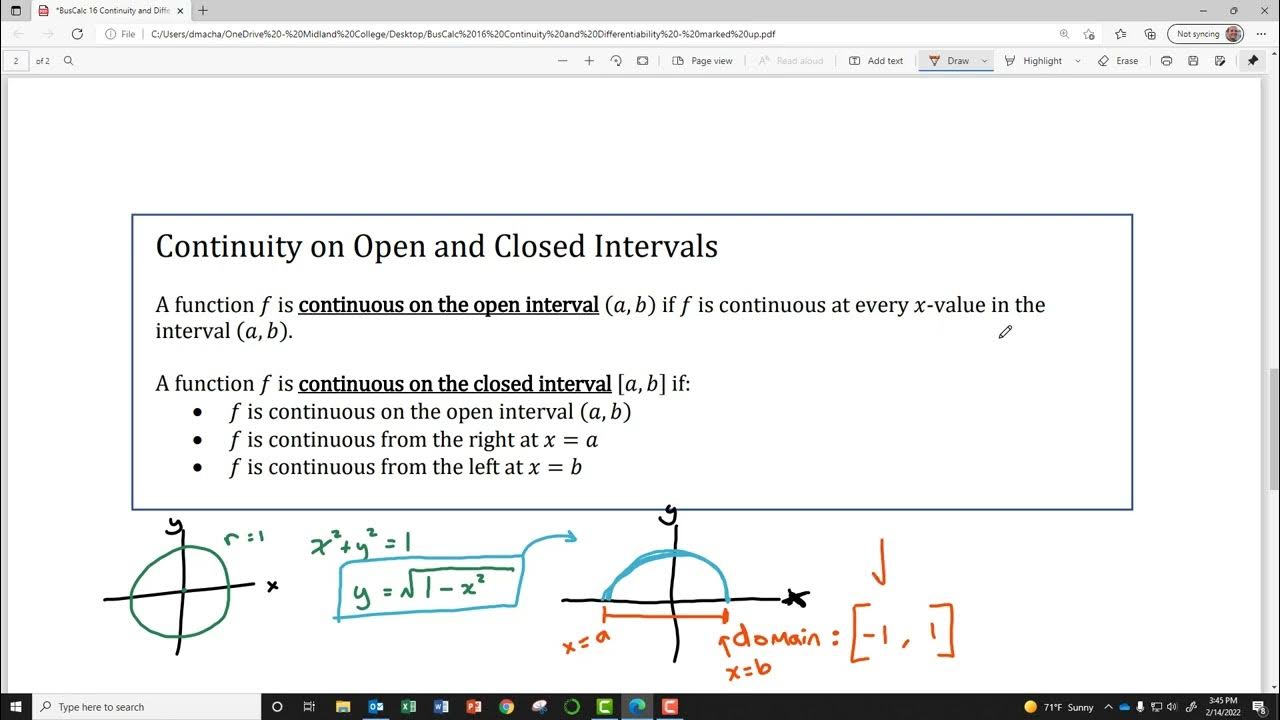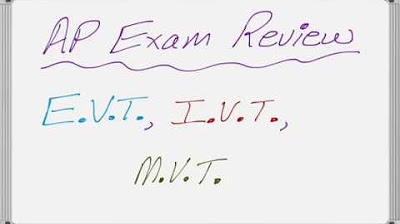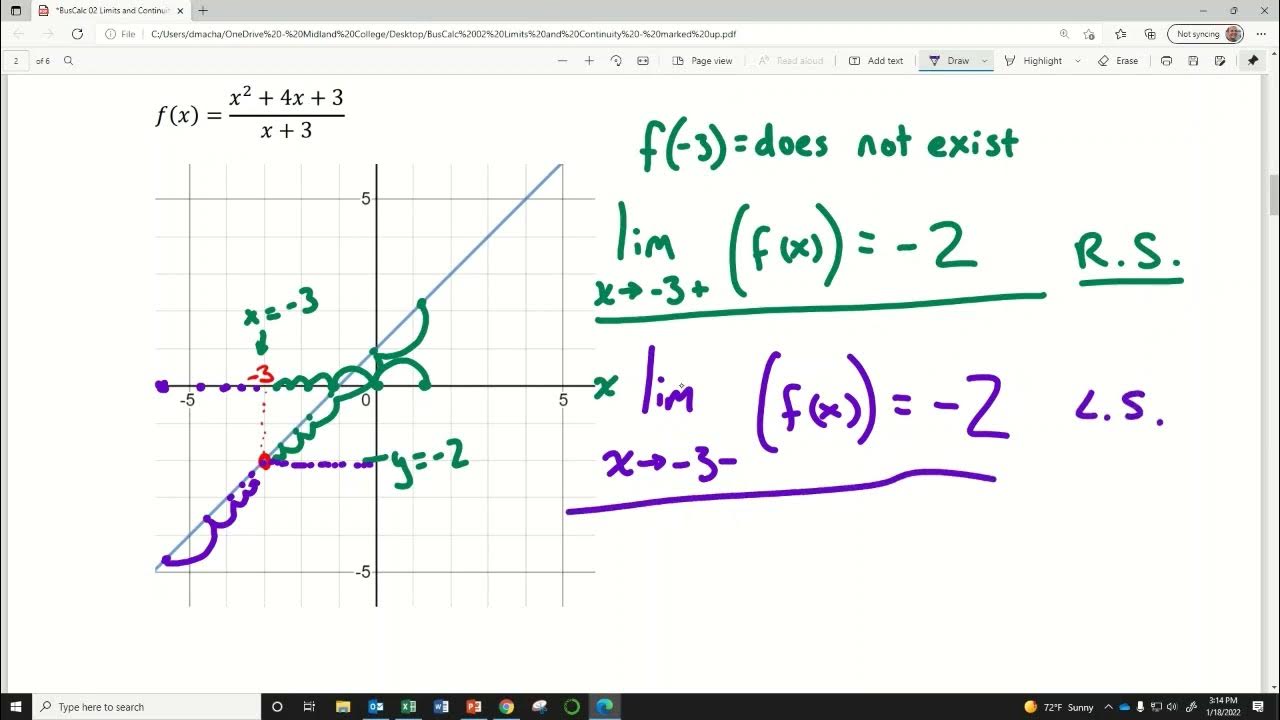Watch Before Diff Eq 11
TLDRThe speaker clarifies a common misconception about the continuity of functions at endpoints, emphasizing its relevance to the existence and uniqueness of solutions to differential equations. They explain that while a function can be continuous at an endpoint with one-sided limits, an open interval is necessary for considering differentiability, which is key in the context of differential equations. The speaker acknowledges their oversight in a previous video and aims to rectify the confusion, ensuring viewers understand that continuity must be considered on an open interval around the initial value, not at an endpoint.
Takeaways
- 📌 The speaker acknowledges making an omission in a previous video related to the topic of existence and uniqueness of solutions to differential equations at initial values.
- ✋ The concept of continuity at endpoints is clarified; true continuity requires considering an open interval around a point, which is not possible at an endpoint.
- 🎥 The video transcript is an explanation to correct a mistake made in a previous video, emphasizing the importance of continuity on an open interval for differentiability.
- 🚫 The speaker did not clearly convey in the video that the statement 'continuity does not exist at an endpoint' is specific to the context of checking initial values for differential equations.
- 🔄 The speaker emphasizes that continuity can exist at endpoints with one-sided limits, but for the purpose of this video, an open interval of continuity is required.
- 📚 The main point is that for the existence and uniqueness of solutions to differential equations, the initial value should not be at an endpoint of the interval of continuity.
- 🤔 The speaker invites viewers to rewatch the video after this clarification to better understand the concept of continuity in the context of differential equations.
- 🧠 The video aims to clear up any confusion caused by the previous omission and to ensure that viewers understand the specific conditions required for the application of the concepts.
- 📈 The discussion is focused on the mathematical analysis of differential equations and the conditions under which solutions exist and are unique.
- 📝 The speaker's intention is to ensure that the audience grasps the nuances of the topic, especially the critical aspect of initial value placement within intervals of continuity.
- 🗣️ The speaker apologizes for any confusion caused by the lack of clarity in the previous video and seeks to rectify it with this additional explanation.
Q & A
What is the main topic of the video?
-The main topic of the video is the existence and uniqueness of solutions to differential equations at initial values.
Why does the speaker mention an omission in the video?
-The speaker mentions an omission because they failed to clarify that continuity does not exist at endpoints when discussing the context of initial value problems for differential equations.
What does the speaker mean by 'continuity does not exist at an endpoint'?
-By 'continuity does not exist at an endpoint', the speaker means that if the initial value is at the endpoint of a continuity interval, there isn't enough space for an open interval and neighborhood around it, which is necessary for differentiability.
How can a function have continuity at an endpoint?
-A function can have continuity at an endpoint if one-sided limits are considered, but this is not the context being discussed in the video.
What is the importance of having an open interval of continuity around the initial value?
-Having an open interval of continuity around the initial value is important for checking the existence and uniqueness of solutions to differential equations, as it allows for differentiability at that point.
Why can't the initial value be at an endpoint according to the video?
-The initial value cannot be at an endpoint because there wouldn't be an open interval of continuity around it, which is required for the existence and uniqueness of solutions in the context of the video.
What should viewers do if they find the video confusing?
-If viewers find the video confusing, they should come back and watch the clarification part again to better understand the concept of continuity and its relation to initial values and endpoints.
How does the speaker attempt to rectify the omission?
-The speaker attempts to rectify the omission by providing a detailed explanation and clarification of the concept of continuity at endpoints before the video proceeds.
What is the relationship between continuity and differentiability in the context of the video?
-In the context of the video, continuity is a prerequisite for differentiability. The speaker emphasizes that an open interval of continuity is necessary to ensure differentiability at the initial value point.
What does the speaker hope to achieve by providing this clarification?
-The speaker hopes to enhance the viewer's understanding of the video content by clarifying the concept of continuity at endpoints and its importance in the context of differential equations with initial values.
Outlines
📝 Clarification on Existence and Uniqueness of Solutions
The speaker acknowledges an omission in a previous video regarding the existence and uniqueness of solutions to differential equations at initial values. They clarify that continuity does not exist at endpoints when considering initial values for differential equations. The speaker emphasizes that for differentiability, an open interval around the initial value is required, which is not possible if the initial value is at an endpoint. The correction is made to ensure understanding that continuity, in the context of this video, refers to an open interval and not one-sided limits at endpoints.
Mindmap
Keywords
💡Existence and uniqueness of solutions
💡Differential equations
💡Initial values
💡Continuity
💡Open interval
💡Endpoints
💡Differentiability
💡Neighborhood
💡One-sided limits
💡Omission
💡Transcript
Highlights
The speaker acknowledges an omission in a previous video.
The video's topic is about the existence and uniqueness of solutions to differential equations at initial values.
Continuity does not exist at endpoints, which may mislead viewers if not clarified.
A function can be continuous at an endpoint if considered from one side of the limit.
When checking initial values, continuity on an open interval around that point is necessary due to differentiability.
The speaker clarifies that continuity does not exist at an endpoint when the initial value is at the interval's endpoint.
An open interval and neighborhood are required for continuity, which is not possible if the initial value is at an endpoint.
The speaker emphasizes that continuity at an endpoint is not applicable for checking existence and uniqueness in this context.
Continuity can exist at endpoints with one-sided limits, but not for the purposes of this video.
For differentiability, an open interval of continuity around the initial value is required.
The initial value cannot be at an endpoint for the purposes of this video's topic.
The speaker apologizes for the potential confusion and encourages viewers to rewatch the clarification.
The video aims to clarify that for checking existence and uniqueness, an open interval of continuity is essential.
The speaker reiterates that continuity at an endpoint is not feasible for the context of differentiability and initial value checking.
The video's main point is that an initial value at an endpoint does not allow for an open interval of continuity.
The speaker hopes the clarification makes the concept clearer for the viewers.
The video is intended to correct a mistake and provide a better understanding of the topic.
Transcripts
Browse More Related Video
5.0 / 5 (0 votes)
Thanks for rating:





